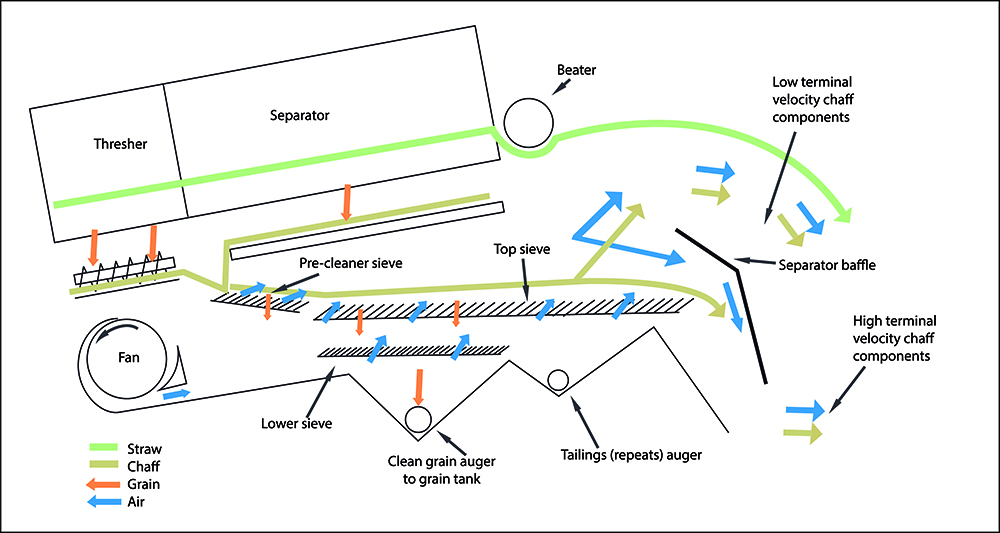Getting weed seed into the header’s chaff stream
All harvest weed seed control methods rely on getting the weed seed in the front of the header and then onto the sieve, along with the harvested grain and chaff. Sounds easy enough, however experience has shown that doing some modification to the header set up can capture more weed seed and prevent it going out the rotor along with the straw.
The bonus that comes from making adjustments that capture more weed seed is that you will also capture more grain—another win win.

In the back end of the harvester, a separator baffle can be installed to split the air flow from the rotor and the air flow from the sieve. The 25–30 cm high baffle stops the weed seed from being blown over the top of the chaff stream and into the straw spreader.
Ray Harrington, a West Australian grain grower and long-time innovator, believes that all modern harvesters need some adjustment so they are better setup to target weed seed during harvest. It is critical that all the weed seeds exit in the chaff for harvest weed seed control (HWSC) systems such as chaff carts, Harrington Seed Destructor and chaff tramlining.
Assuming that the harvester is operated low to the ground, with the front cutting no higher than beer can height, most weed seeds that are present at harvest will go into the harvester.
Once inside the machine the key for successful weed seed capture is to make sure that the weed seed and the grain all comes out of the rotor and onto the sieves. To achieve this Ray recommends modifying the second concave, such as removing every second wire in the concave frame in the Case 8230. Other harvesters have different construction but the principle remains the same.
Since the straw component is still very long at this point of the process Ray says there is no need to have narrow slots in the second concave. Keep experimenting until you find the perfect set up for your machine.
Likewise, there can be a benefit derived from making larger holes in the harvester grates of some models. In the Case 8230 Ray has found that the grates don’t need modification as the holes are already quite large.
With harvested material only being in the rotor for a few seconds, it is important to make sure that the inside wall of the concave is not lined with straw, making it difficult for the weed seed and grain to go through the gaps and onto the sieve. Ray has installed an extra bar inside the rotor to help keep all the harvested material moving as it flows through, maximising the opportunities for weed seed and grain to separate from the straw and fall through the concave.
For each model, and even for different crops, there needs to be a different set up. Ray recommends experimenting and adjusting until maximum weed seed and grain are being collected on the sieve.
He knows from his own farm that a surprising amount of grain, let alone weed seed, can travel in the front and straight back out on the paddock if the settings are not right. In canola particularly Ray has seen more than 0.5 t/ha of grain going back out through the spinners.
In the back end of the harvester Ray is using a separator baffle to split the air flow from the rotor and the air flow from the sieve. The 25–30 cm high baffle stops the weed seed from being blown over the top of the chaff stream and into the straw spreader.
Ray says that because the weed seed has a kernel it will not rise higher than the baffle height and so joins the chaff stream and is directed into the Harrington Seed Destructor, onto the chaff cart belt or down the narrow windrow chute.
Keeping a 25–30 cm gap around the baffle allows the high volume, low pressure air flow to efficiently separate the grain from the chaff and weed seed, and the baffle keeps the weed seed from being caught up in the straw as it flows over the top through the choppers and out through the spinners.
In the diagram below, drawn by engineer Nick Berry, shows how a separator baffle can be used to divert more weed seeds into the Harrington Seed Destructor (HSD) mills. These baffles come in all shapes and sizes, and are often custom made by grain growers to fit their harvesters. The aim is to divert the weed seed containing chaff fraction below the baffle to collect at least 95 to 98% of the weed seeds with one of the many HWSC tools.

This diagram, drawn by engineer Nick Berry, shows how a separator baffle can be used to divert more weed seeds into the Harrington Seed Destructor (HSD) mills. The same concept applies for chaff carts and chaff lining.
Once everything is correctly set up, Ray says his experience, and trials conducted by Dr Michael Walsh from AHRI, indicate that it is realistic to expect that only 2 per cent of the weed seed that enters the header will end up evading harvest weed seed capture.
Dr Michael Walsh from AHRI conducted 25 trials across Australia comparing weed seed capture of the chaff cart, narrow windrow burning and the Harrington Seed Destructor. He and Charlie Aves did ryegrass counts in the following autumn and found that the three HWSC tools performed equally, reducing the ryegrass germination by 56% on average. If there were significant rotor losses, and weed seeds were spread with the straw, the narrow windrow burning treatment would be expected to perform better than the other treatments because windrow burning removes all of the straw and chaff while the chaff cart and HSD remove the chaff only.
Listen to Ray talk with AHRI’s Peter Newman about setting up your harvester:


